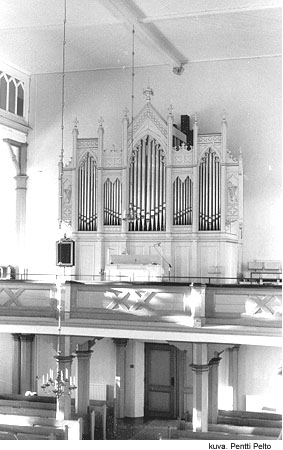|
HISTORICAL ORGANS IN FINLAND 
Somero Church- Zachariassen, Jens Alexander 1880
- 19 stops, 2 manuals and pedal
- mechanical action and mechanical stop action
Somero Church is a Neo-Gothic brick church built to a plan by architect G.Th. Chiewitz in 1859. The organ, built in 1880, is the largest preserved mechanical organ built by Zachariassen. The organ was repaired and its disposition changed in 1964 and 1970. In the most recent repairs carried out by Jouko Pirkkanen and Arno Pello in 1998-99, the disposition, wind supply and sound were restored to their original guise. It was of great help to this project that the original removed parts had been preserved.
The Somero organ is, in terms of both technical properties and sound, a fine example from a period when many organs were built in Finnish churches for the primary purpose of accompanying congregational hymn singing. This organ is also significant because of its size and quality. The simplified construction and the builder’s fine overall command of his skills are evident in the instrument.
Appearance
The Neo-Gothic façade of the organ has five flats and side panels on either side with harp decorations. The tops of the flats are pointed arches. The middle flat is topped by a pediment, while the flanking ones are oblong. Some of the façade pipes speak, while others are dummies.
Zachariassen seems to have had a habit of drawing façades without any specific instrument in mind, since he also tended to use the same façade drawing several times. The organ in Hattula has a façade identical to that of the Somero organ, and the organ in Hauho has a very similar though somewhat narrower façade.
The chest shared by both manuals is immediately behind the façade of the Somero organ. Behind that is the tuning access space, then the Pedal chest and at the very rear the group of four box bellows. The conventional design — in line — was obviously considered so self-evident that the builder did not abandon it even though the organ loft in Somero Church is of a restricted depth. As a result, doing maintenance work on the console is somewhat difficult.
Technical features
The manuals share a chest which is divided into two halves. It rests on transverse beams whose front end is embedded in the façade structure and whose back end rests on a separate primary beam. The pallet division of the chests progresses alternately, with the large ones in the middle and the small ones at the sides.
The console is a separate structure in front of the organ. The naturals have a bone covering, while the sharps have an ebony covering. The stop knobs, which are large and have a long movement, are terraced in three rows on both sides of the keyboards. The stop ends are of porcelain, with printed texts. A pair of forte pedals to activate and deactivate loud stops (a device typical for Zachariassen) is included here too. They enable the organist to quickly change the loudness of the instrument, although the stops connected to these pedals cannot be changed.
The components of the action are quite large and robust, but sensitively mounted. The touch is light when playing slowly, but in a fast tempo the inertia of the action renders the touch quite heavy.
Sound
Zachariassen’s metal pipes have several idiosyncratic properties. The lips are softly depressed, the languid bevel is rather small, and the lower end of the foot is almost open. Typically for the period, the pipes have tuning slots. The main manual is broad, strong and rich in sound, well suited for supporting congregational singing. Manual II contains several quiet stops for playing preludes and accompaniments. The Pedal provides a strong bass foundation. The instrument is a natural and attractive vehicle for playing music from its own era. Despite its warmth, the sound comes across as slightly aloof and dignified.
Disposition
Manual I C-f3 | Manual II C-f3 | Pedal C-d1 |
Borduna 16’ | Geig.principal 8’ | Principal 16’ |
Principal 8’ | Rörflöjt 8’ | Subbas 16’ |
Major-flöjt 8’ | Fugara 8’ | Principal 8’ |
Viola di Gamba 8’ | Gambetti 4’ | Violoncello 8’ |
Gedacht 8’ | | Bassun 16’ |
Oktava 4’ | | I-Ped |
Oktava 2’ | | II-Ped |
Mixtur 3chor | | |
Trompet 8’ | | |
| | |
| | |
| | |
/-Forte pedals | | |
|